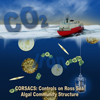 | CORSACS:
Controls on Ross Sea Algal Community Structure
2005: A Research Cruise to the
Ross Sea to Study What Controls the Phytoplankton DynamicsFrom December
17th 2005 to January 27th 2006, a team of scientists from universities and research
institutions from around the world explored the ecosystem of the Ross Sea near
the continent of Antarctica. The Ross Sea is teeming with small plants, known
as algae.Globally, the algae that live in surface ocean are a major part of the
cycling of carbon on Earth, because as algae grow they photosynthesize and use
carbon dioxide to grow. Hence, just as we are concerned about the loss of forests
on the continents and its implications for climate change, studying what controls
the growth of these algae in the oceans is just as important in understanding
how carbon cycles on Earth. This team of scientists is exploring the ecological
struggle between two major groups of algae: Diatoms and Phaeocystis. They have
hypothesized that these groups of algae have different nutritional preferences,
and that changes in the nutrient chemistry of the seawater where the algae live
will influence this ecological struggle - allowing one group to outcompete the
other.The nutrients the team will focus on include a number of elements that all
biology needs to survive including: carbon, nitrogen, phosphorus, iron, and cobalt.
To achieve these scientific goals, the team includes biological oceanographers
and chemical oceanographers who will study the algal biology and the seawater
chemistry, and the research cruise has been named CORSACS: Controls on Ross Sea
Algal Community Structure. Explore the links below for more information. Chief
Scientist's Log Life at Sea Technology
and Instrumentation Questions from
Visitors and Answers from Scientist Aboard the Research Vessel Palmer |

